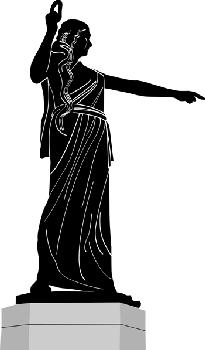|
 Dusted
off the museum dungeons and given a fresh coat of paint,
Kannagi is back on her proud pedestal on the scenic Marina shores (of
Chennai) striking her famous pose — right hand clenching the ruby-crusted
anklet, pointing out imperiously. But even after her dramatic return to
Chennai’s landscape, at a gala function by CM
M Karunanidhi
on his birthday on June 3, Kannagi is still in the news. Reacting to a muted
warning by Karunanidhi against ‘critics’ of Tamil culture, DMK workers today set
fire to copies of Ananda Vikatan, a Tamil weekly, for daring to criticise the
new government’s move to get Kannagi back on her perch. Dusted
off the museum dungeons and given a fresh coat of paint,
Kannagi is back on her proud pedestal on the scenic Marina shores (of
Chennai) striking her famous pose — right hand clenching the ruby-crusted
anklet, pointing out imperiously. But even after her dramatic return to
Chennai’s landscape, at a gala function by CM
M Karunanidhi
on his birthday on June 3, Kannagi is still in the news. Reacting to a muted
warning by Karunanidhi against ‘critics’ of Tamil culture, DMK workers today set
fire to copies of Ananda Vikatan, a Tamil weekly, for daring to criticise the
new government’s move to get Kannagi back on her perch.
The first spark was lit by N Y Sankaran (who goes by the pseudonym, Gnani), who
in his column in the Tamil weekly compared DMK’s ‘passion’ for Kannagi to ‘‘some
children who never outgrew a teddy bear.’’
Kannagi is the legendary heroine of the ancient Tamil literary work ‘Silapathigaram’
written by Ilango Adigal. Seen as an enduring symbol of Tamil culture and
chastity, her statue was installed in 1968 during the DMK regime under
C N Annadurai. But the statue suddenly disappeared in December 2001 when the
AIADMK was in power with rumours abounding that it had been removed after
warnings of doom by astrologers and ‘vaastu’ experts close to Jayalalithaa.
According to Silapathigaram, Kannagi’s husband Kovalan was beheaded on the
orders of the King of Madurai after being accused of stealing the queen’s anklet
(with pearls inside) and selling it. Kannagi went to the King’s court to demand
justice and proved to him that Kovalan was trying to sell her anklet, which had
rubies and not pearls inside it. While the King and queens die of remorse,
Kannagi burned down Madurai with a curse.
In his column, Gnani wondered how Kannagi accepting her husband Kovalan, who
returned after deserting her for 10 years for a courtesan, Madhavi, was relevant
to present day situation. Today, a marriage is termed dead if a husband deserts
his wife for more than seven years. He also asked what the crime of the people
of Madurai was that they had to die too. Gnani equated the ‘mystery’ of the
statue’s disappearance during Jayalalithaa’s regime to the ‘yellow shawl’ always
worn by Karunanidhi.
The columnist’s views evoked a sharp reaction from Karunanidhi, who warned
against ‘‘playing with fire by provoking Tamil sentiments.’’ The statue, which
had been installed taking into consideration its ‘‘hoary tradition’’ had been
treated like ‘‘a beggar’’ by the previous government, he said. ‘‘Tamil had
fallen into ruins (during the previous regime). Instead of giving a helping hand
some people are hindering the process,’’ Karunanidhi said during the Saturday
function when the Kannagi statue was reinstalled.
|